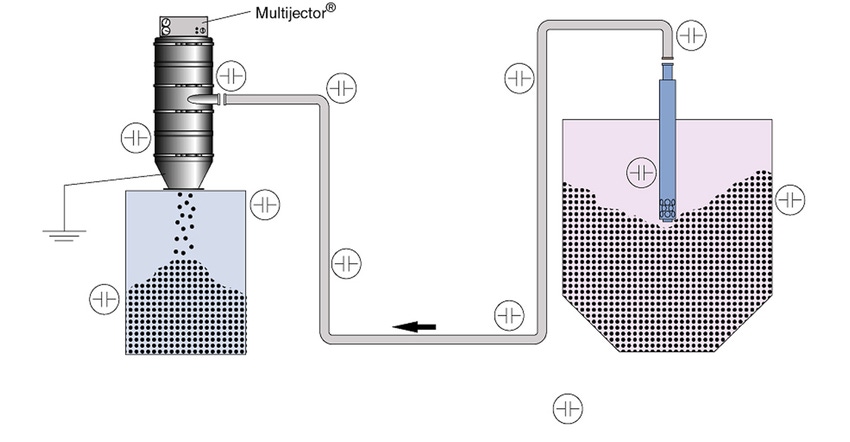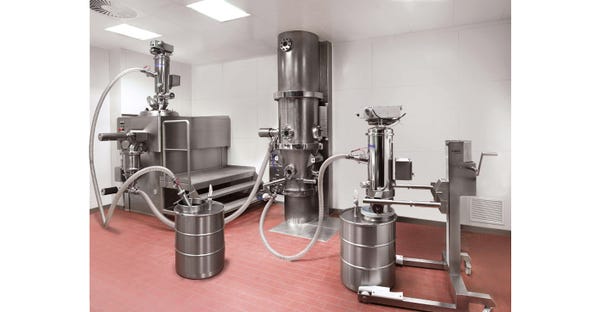Explosion Avoidance: Safer than Containment and Suppression
This article describes the importance of avoiding explosions to eliminate risk and liability – and save lives.
August 24, 2021

David Nichols, vice president of sales and marketing, Volkmann USA
Powder processing and combustible dust explosions occur far too often considering the vast base of knowledge and experience accumulated among process engineers, process equipment manufacturers, industrial safety professionals, and explosion protection system suppliers. An average of 31.8 combustible dust explosions happen every year in the US alone, according to the DustSafetyScience 2020 Combustible Dust Incident Report, mostly involving the food, wood, and metals industries. Many of these explosive incidents caused fatalities, serious injuries, and triggered financial losses in the millions. Few would argue that explosions need to be avoided. Yet for many companies, the standard procedure for managing explosion hazards calls for suppressing, containing, or venting explosions - after the explosions occur. These suppressed, contained, or vented explosions cause much less damage than if there were no suppression, containment, or venting systems in place, but doesn’t it make more sense to prevent explosions from occurring in the first place? Avoiding an explosion at the conveying equipment design and specification stage eliminates the risk and liability entirely. To eliminate the risk of explosion hazards in pneumatic vacuum conveying systems, first consider the anatomy of such an explosion:
A plastics processor transfers polyethylene powder from storage to a twin screw extruder for mixing and compounding via an automated pneumatic vacuum conveyor, for example. As the material flows through the piping, an electrostatic charge builds up, the greater the conveying velocity, the greater the charge. Since the enclosed conveying system contains the material inside and prevents fine dust particles from escaping into the plant environment, the facility manager, despite paying attention to combustible dust safety, overlooks the danger posed by this electrostatic charge. Though the system was properly grounded at installation, a clamp connecting the conveyor discharge to the extruder infeed hopper was misaligned when returned to service following a routine maintenance check. This simple clamping issue blocks the electrostatic charge from safely dissipating the energy to the earth, resulting in a catastrophic explosion (Figure 1).
Every deflagration requires an ignitable fuel source, oxygen, and an ignition source. In this example, the polyethylene powder provides the ignitable fuel source and the electrostatic charge developed during powder transfer in the absence of proper grounding provides the ignition source. Many factors influence how and when each of these three components conspire to lead to an explosive event but all three must be present.
Other common sources of ignition in powder processing include sparks generated by mechanical action such as a loose nut or bolt grinding inside a rotary valve, open flames from welding equipment or blow torches, and hot external surfaces from nearby dryers, ovens, kilns, or other equipment. Ambient air typically provides the oxygen source with humidity and air pressure serving as key variables influencing the level of risk. The ignitable fuel source provides a virtually limitless array of variables and, therefore, poses the greatest challenge of the three to engineers charged with designing and/or operating a safe process. Ubiquitous materials such as polyethylene, milk powder, and sugar (famously) are well-known, non-hazardous powders yet serve as highly ignitable fuel sources given the right conditions.
To help assess the risk, engineers designing pneumatic vacuum conveying systems use a measurement called minimum ignition energy (MIE). The MIE attempts to quantify the minimum amount of spark energy needed for a given powdered material to ignite, as measured in mJ. Grain dust--the fuel source culprit involved in many industrial explosions--often has an MIE of 55 mJ, powdered sugar 30 mJ, magnesium 20 mJ, polyethylene 10 mJ, and toner 1 mJ. The lower the MIE, the more sensitive the material and the greater the risk of an explosion. An MIE at 100 mJ or less typically demands equipment and staff are properly grounded and systems established to prevent fine particles from becoming suspended in the air. An MIE at 25 mJ or less demands additional consideration due to its high sensitivity to ignition.
Adding to the challenge, materials may yield different MIE results at different times. For example, even very slight changes in the particle size or shape, moisture content, concentration, humidity, and/or air pressure during testing may result in large variations in MIE. If a processing line is designed based on a bulk material with an MIE of 50 but a different supplier delivers the material with an MIE of 40 then trouble may follow. Further, two or more materials with relatively high MIE and low risk of ignition when mixed, reacted, crystallized, conveyed together, or otherwise processed, may measure a very different and far more sensitive MIE downstream than when in storage. These and other characteristics all need to be considered when assessing the risk and likelihood for the material to contribute to an explosion.
To safeguard against the potentially catastrophic consequences of an explosion, many companies invest handsomely in clever systems to suppress, contain, or vent the explosive energy in hopes of minimizing the damage to personnel, equipment, and to ongoing operations. Suppression systems use instrumentation that automatically senses when a deflagration has occurred. The explosive force is mechanically isolated within the vessel or space to keep it from expanding to interconnected equipment while a high pressure, chemical suppressant such as nitrogen instantly extinguishes the reaction. Containment systems focus on designing the process equipment to withstand the maximum pressure projected based on the material in process and other conditions. This may entail adding rupture disks or other relief devices to allow the explosion to occur without incurring catastrophic levels of damage. Similarly, venting features designed-in openings in vessels or other equipment that direct the explosive force to a safer location, such as outside the facility. Rupture panels, hinged doors, and other types of covers may keep the majority of the force contained in one place.
While the engineering behind these systems is both impressive and proven in operation, they share a potentially fatal flaw: They are all designed to operate after the fact – after an explosion occurs.
Preventing Explosions from Occurring
Even a suppressed, contained, or vented explosion typically triggers substantial line downtime to assess damage and affect repairs. Preventing explosions from occurring in the first place seems a far safer, less costly, and more desirable outcome. Recalling that an explosion requires an ignitable fuel source, oxygen, and a source of ignition, such as a spark, to occur, eliminating any one of the three requirements would achieve explosion-proof status. Given that transferring the ignitable powder likely keys the company's operation, eliminating the fuel source is impractical. Oxygen can be removed from the conveying system and replaced with an inert gas such as nitrogen, but this is often an excessive and unnecessary approach for transferring most materials. But eliminating the source of ignition from the equation is both possible and proven effective.

Figure 2: Volkmann-VS-Conveying: The latest pneumatic vacuum conveying systems like this ATEX-certified Volkmann VS Series model 250 eliminate the potential for an explosion rather than suppress, contain, or vent the explosion after the fact.
By operating entirely pneumatically without electricity, without rotating parts, without generating heat, and with proper electrostatic grounding, these conveying systems eliminate the source of ignition as a risk factor (Figure 2). This design earned the ATEX certification as suitable for safe installation in all dust explosion areas. According to the noted Dr. Martin Glor of Swiss Process Safety Consulting GmbH, for handling powders with low MIE, avoiding effective ignition sources typically should not be applied as the only protective measurement, “However, Volkmann vacuum conveyors, due to the avoidance of effective ignition sources, can be applied as a sole protective measurement.”
Hundreds of these conveying systems worldwide transfer powders, granules, flakes, and other bulk materials as specified without incident.
As companies invest in workplace safety initiatives and divert resources to comply with the many regulatory requirements, guidelines, codes, and recommendations, savvy engineers are rethinking the logic of allowing explosions to occur by design and recognizing that avoiding explosions offers a more certain approach to safeguarding employees, minimizing risk, and keeping production moving.
David Nichols is vice president of sales and marketing for Volkmann USA. The company designs and manufactures ATEX-certified pneumatic vacuum conveying systems suitable for transferring ignitable dry powders down to 1 mJ MIE or lower and presents ATEX safety seminars for processors operating in explosive environments. For more information, call 609-265-0101 or visit www.volkmannusa.com.
You May Also Like

